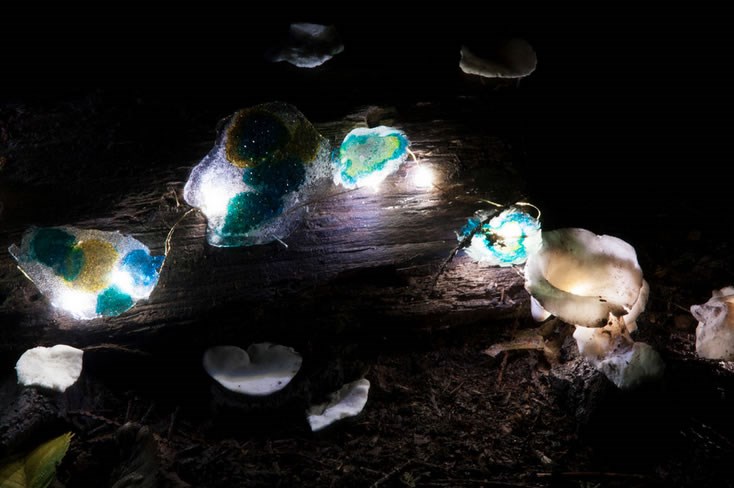For Kathryn Wadel, there’s a particular artistic satisfaction in having her work included in a show celebrating the spring equinox.
The piece she’s contributing to Luminescence IV is a rework of an earlier installation, created for the Still Moon Arts Society’s Renfrew Ravine Moon Festival in 2018 – a festival that marks the fall equinox.
“It’s sort of come full circle,” she says.
Wadel’s work, Mycelial Connections, centres around fungi, featuring an illuminated network of mushrooms sculpted from clay and found materials. She’s pleased about the fact that a piece based on mushrooms – usually associated with decay and death – can be part of a show marking the coming of spring.
“I’m really, really happy it gets to be part of a show that celebrates rebirth,” she says.
Initially an outdoor installation, Wadel has reworked it for indoors by creating a 36-by-36-inch backdrop inspired by the trees. Creating site-specific works is something she enjoys, she says; she likes to “promote different ways of engaging the audience not just with the piece but with the space around them.”
The Luminescence show was a natural fit for Wadel, whose practice includes a focus on light and light-based sculptures.
One of her recent large projects was a group exhibition in 2018, Leaning Out of Windows, a partnership between Emily Carr University and the TRIUMF particle accelerator centre at UBC. Discovering that the physicists at TRIUMF use light as their base medium for finding particles, Wadel chose to explore that idea of a particle accelerator through an artistic lens. She used found glass materials and a projected self-portrait to help explore the idea of how light helps us see things that would otherwise be invisible.
During her research, she discovered that light exists as two things at the same time – “as a photon, it exists as a particle and a wave” – and she used that idea to explore her own mixed Filipino-German-Scottish heritage and her existence as “more than one thing at a time.”
Yes, her connection to science is strong; Wadel says she’s always been interested in science, though she veered towards art when she was forced to choose between art and science during her international baccalaureate studies in high school.
That she would choose art was never really in doubt for Wadel.
“Honestly, it’s just been something I’ve done my whole life,” she says. “I was one of those kids who drew in books and on walls. Give me a crayon and I’ll draw.”
The Toronto native moved west to study art at Emily Carr University, where she graduated in 2017, and she now makes her home in Burnaby. She’s an associate of the James Black Gallery in Vancouver, where she keeps her studio.
“I’ve found my practice cycling back to science,” she admits. “Now my practice can go between art and science. Science is one of my primary inspirations: science and community engagement.”
The community engagement piece is one that fits in well with Deer Lake Gallery, which has an increasing focus on events that get the public involved in art. Wadel was one of the wild-card entries in a recent live paint-off event at the gallery, among a group of artists who had two hours to fill a 24-by-36 canvas.
“It was one of those moments as an artist that I really love doing – giving yourself a limitation … and just working instinctively and intuitively. It’s those moments that bring me joy,” she says, adding it’s also a particular thrill to be part of a group of people all creating simultaneously. “You can just feel the creative energy.”
Now, Wadel is looking forward to seeing how the public responds to the works in Luminescence – and to seeing what other artists have done with the idea of light.
“I’m really interested in seeing how different artists use light in their practices,” she says, noting that the show is sure to be eye-opening for viewers. “It does have so many different access points as well. (Light) is something they use in their daily life that they may not think of as an artistic medium.”



